Liquid-liquid extraction is a core separation method in chemical engineering, used across various industries to isolate or purify compounds based onDynamics 365 consulting Sydney their affinity for different immiscible liquids. This process offers flexibility in separating components, especially those sensitive to heat or those with close boiling points, making it a versatile alternative to traditional methods like distillation. To optimize this process, a clear understanding of how liquid-liquid extractors work, along with informed solvent selection, is critical.
How Liquid-Liquid Extractors Work
Liquid-liquid extractors function by introducing two immiscible liquids—typically an aqueous feed and an organic solvent—that allow targeted compounds to transfer from one phase to another. This transfer depends on the partition coefficient, which dictates how a compound distributes itself between the two liquids. The extraction process usually involves a series of stages where the liquids are agitated to increase the contact surface area and facilitate compound transfer.
There are multiple configurations of liquid-liquid extractors:
- Mixer-Settler Extractors: These use individual chambers for mixing and settling, enabling precise control over mixing time and phase separation.
- Column Extractors: In these continuous systems, liquids move counter-currently through packed or spray columns, with repeated stages enhancing separation.
- Centrifugal Extractors: Using centrifugal force, these extractors enable rapid separation, suitable for high-throughput requirements in industries where time and space are at a premium.
Advantages of Liquid-Liquid Extractors
The chosen over other methods due to several advantages of liquid-liquid extractors:
- Thermal Stability: This process operates at ambient or low temperatures, preserving compounds that are sensitive to heat and preventing degradation.
- Enhanced Selectivity: By selecting a solvent with a high affinity for the target compound, operators can achieve high purity levels with fewer stages, reducing operational complexity.
- Energy Efficiency: Since liquid-liquid extraction doesn’t rely on heating to separate components, it typically consumes less energy than distillation, making it more sustainable for large-scale applications.
- Applicability to Complex Mixtures: Liquid-liquid extraction is particularly effective for mixtures where components have similar boiling points or where phase separation is otherwise challenging.
These advantages make liquid-liquid extractors valuable in processes that demand high purity and gentle handling, such as in the pharmaceutical, petrochemical, and food industries.
Solvent Selection for Liquid-Liquid Extraction
Solvent selection is arguably the most critical factor in optimizing liquid-liquid extraction. A suitable solvent maximizes extraction efficiency and minimizes operational costs while ensuring safety and environmental compliance. Key criteria in solvent selection include:
- Affinity and Selectivity: The solvent must selectively dissolve the target compound while leaving impurities behind. High selectivity reduces the need for secondary purification processes, streamlining the workflow.
- Density and Viscosity: Solvents with an appropriate density difference relative to the feed phase facilitate phase separation. Meanwhile, a low-viscosity solvent can enhance mass transfer rates, making the process faster and more efficient.
- Partition Coefficient: The ideal solvent should have a high partition coefficient for the desired compound, maximizing the distribution ratio and reducing the solvent volume needed for effective extraction.
- Environmental and Safety Considerations: Safety regulations play a significant role in solvent selection. Operators often choose solvents with low toxicity, non-volatility, and minimal environmental impact. Emerging options like ionic liquids and supercritical fluids are gaining interest due to their lower toxicity and environmental benefits, even though they may require specialized equipment and handling.
In practice, common organic solvents like hexane, toluene, and dichloromethane are widely used, though greener alternatives are increasingly favored as industries seek sustainable solutions.
Applications of Liquid-Liquid Extractors
Liquid-liquid extractors are applied in numerous fields due to their ability to isolate or purify valuable compounds efficiently:
- Pharmaceutical Industry: Liquid-liquid extraction is used to separate active pharmaceutical ingredients from raw materials or impurities, ensuring high purity in drug formulations.
- Petrochemical Industry: These extractors facilitate the removal of aromatic compounds from hydrocarbon mixtures, optimizing fuel quality and refining efficiency.
- Environmental Engineering: In wastewater treatment, liquid-liquid extraction removes heavy metals, organic pollutants, and other contaminants from water, enhancing environmental safety.
- Food and Beverage Industry: Extractors are used to isolate essential oils, flavors, and fragrances, maintaining their quality for use in food products or perfumes.
Each industry requires different extraction parameters, underscoring the importance of customizing liquid-liquid extractors to meet specific application needs.
Design and Operation of Liquid-Liquid Extractors
The effectiveness of a liquid-liquid extractor is influenced by its design and operational parameters. Engineers choose between various extractor types based on the process requirements, such as the target purity level, feed composition, and throughput demands.
- Mixer-Settlers: These extractors allow for individual control of the mixing and settling stages, making them suitable for multi-stage extractions where high precision is needed. They are common in solvent-intensive processes like metal extraction.
- Packed and Spray Columns: These are continuous flow systems that handle large volumes efficiently. Packed columns, which contain a packing material to increase surface area, are highly effective for achieving high levels of separation in counter-current flow setups. Spray columns are simpler in design, suited for processes that don’t demand high separation efficiency.
- Centrifugal Extractors: By using centrifugal force, these extractors rapidly separate phases, allowing high-throughput processing in compact equipment. This design is ideal for time-sensitive processes in industries where space constraints are a consideration.
Operating conditions, such as temperature, agitation speed, and pressure, must be closely controlled to optimize the extraction efficiency and ensure process safety. Additionally, routine maintenance and solvent management play a significant role in maintaining the extractor’s performance and longevity.
Liquid-liquid extraction provides a robust, adaptable, and energy-efficient method for separating complex mixtures in various industries. By carefully selecting solvents, designing extractor systems, and optimizing operational parameters, engineers can ensure that liquid-liquid extractors meet both performance and sustainability goals.
